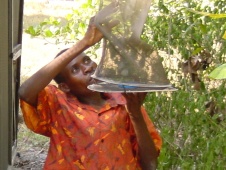
Arabuko-Sokoke Forest lies close to the Indian Ocean near Malindi, Kenya. The forest is remarkable for its biodiversity and is critical for many people’s livelihoods. However, although a Forest Reserve, it has suffered from unsustainable use and illegal activities. Through a number of projects coordinated by BirdLife International and Nature Kenya (BirdLife in Kenya), considerable gains for conservation and local livelihoods have been made over the last twenty years, including improved governance through pioneering Participatory Forest Management and the establishment of a diversity of sustainable, forest-based industries including honey production, butterfly farming and ecotourism.
Arabuko–Sokoke Forest lies close to the Indian Ocean near Malindi, Kenya, surrounded by 53 villages and at least 110,000 people. It is remarkable for its biodiversity and is critical for many people’s livelihoods. Although a Forest Reserve, it has suffered considerably from unsustainable use and illegal activities, such as poaching and illegal logging. Through projects funded by a number of donors and coordinated by BirdLife International and Nature Kenya (BirdLife in Kenya), considerable gains for conservation and the local economy have been made over the last twenty years. This has improved governance through pioneering Participatory Forest Management action, the formation of an Arabuko–Sokoke Forest Management Team (comprised of various Government departments and Nature Kenya supporting local community representation), the establishment of an active Arabuko–Sokoke Forest Adjacent Dwellers Association, and the agreement (in 2002) of a 25-year Strategic Management Plan.
Arabuko–Sokoke Forest provides a good example of the diversity of opportunities that exist for linking sustainable resource management to people’s livelihoods, and how institutions in support of this can become catalysts for a range of social protection measures. Working with local people, a wide array of successful income-generating activities have been established. These include butterfly farming, bee keeping, mushroom farming, aloe farming, ecotourism and farm forestry. Benefits from the award-winning community-based butterfly farming initiative—the Kipepeo Project—are noteworthy. Cumulative community earnings from the sale of butterfly pupae from 1994 to 2005 exceeded US$750,000 with significant positive effects on both livelihoods and attitudes towards the forest. Ecotourism and environmental education have been enhanced through the vibrant Arabuko–Sokoke Forest Guides Association and a unique Schools and Ecotourism Scheme run by A Rocha Kenya, a Christian conservation NGO. Honey has been particularly successful and production still cannot keep pace with local demand.
The diversity of income generating activities that local people are engaged in at Arabuko–Sokoke Forest have helped reduce local people’s vulnerability to environmental and economic shocks and trends—such as drought when honey production is low. Significant non-financial benefits have also arisen. With the support of Nature Kenya and funding from Kindernothilfe (KNH) and NABU (BirdLife in Germany), local people living next to the forest constructed and now manage 11 kilometres of pipeline providing fresh water to their villages. A range of community based organisations around the forest are actively networking and receiving training in business skills, production, quality control and marketing of forest-products. Forest-adjacent communities are empowered and actively engaged in forest management issues that affect them. In return, there is a greater appreciation of the value and importance of the forest which helps ensure Arabuko–Sokoke is conserved into the future.
Related Sites
References
Compiled: 2008
Recommended Citation:
BirdLife International (2008)
Improved livelihoods at Arabuko-Sokoke Forest in Kenya.
Downloaded from https://datazone.birdlife.org/sowb/casestudy/improved-livelihoods-at-arabuko-sokoke-forest-in-kenya on 22/12/2024